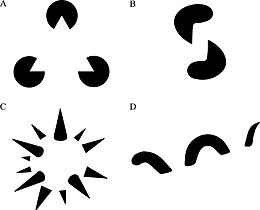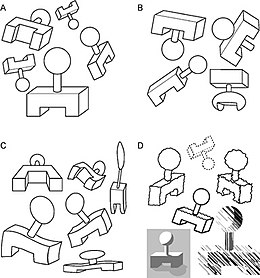In philosophy and logic, the classical liar paradox or liar's paradox or antinomy of the liar
is the statement of a liar that he or she is lying: for instance,
declaring that "I am lying". If the liar is indeed lying, then the liar
is telling the truth, which means the liar just lied. In "this sentence
is a lie" the paradox
is strengthened in order to make it amenable to more rigorous logical
analysis. It is still generally called the "liar paradox" although
abstraction is made precisely from the liar making the statement. Trying
to assign to this statement, the strengthened liar, a classical binary truth value leads to a contradiction.
If "this sentence is false" is true, then it is false, but the sentence states that it is false, and if it is false, then it must be true, and so on.
If "this sentence is false" is true, then it is false, but the sentence states that it is false, and if it is false, then it must be true, and so on.
History
The Epimenides paradox (circa 600 BC) has been suggested as an example of the liar paradox, but they are not logically equivalent. The semi-mythical seer Epimenides, a Cretan, reportedly stated that "All Cretans are liars."
However, Epimenides' statement that all Cretans are liars can be
resolved as false, given that he knows of at least one other Cretan who
does not lie. It is precisely in order to avoid uncertainties deriving
from the human factor and from fuzzy concepts that modern logicians
proposed a "strengthened" liar such as the sentence "this sentence is
false".
The paradox's name translates as pseudómenos lógos (ψευδόμενος λόγος) in Ancient Greek. One version of the liar paradox is attributed to the Greek philosopher Eubulides of Miletus who lived in the 4th century BC. Eubulides reportedly asked, "A man says that he is lying. Is what he says true or false?"
The paradox was once discussed by St. Jerome in a sermon:
"I said in my alarm, Every man is a liar!" Is David telling the truth or is he lying? If it is true that every man is a liar, and David's statement, "Every man is a liar" is true, then David also is lying; he, too, is a man. But if he, too, is lying, his statement that "Every man is a liar", consequently is not true. Whatever way you turn the proposition, the conclusion is a contradiction. Since David himself is a man, it follows that he also is lying; but if he is lying because every man is a liar, his lying is of a different sort.
The Indian grammarian-philosopher Bhartrhari
(late fifth century AD) was well aware of a liar paradox which he
formulated as "everything I am saying is false" (sarvam mithyā bravīmi).
He analyzes this statement together with the paradox of
"unsignifiability" and explores the boundary between statements that are
unproblematic in daily life and paradoxes.
There was discussion of the liar paradox in early Islamic tradition for at least five centuries, starting from late 9th century, and apparently without being influenced by any other tradition. Naṣīr al-Dīn al-Ṭūsī could have been the first logician to identify the liar paradox as self-referential.
Explanation and variants
The problem of the liar paradox is that it seems to show that common beliefs about truth and falsity actually lead to a contradiction.
Sentences can be constructed that cannot consistently be assigned a
truth value even though they are completely in accord with grammar and semantic rules.
The simplest version of the paradox is the sentence:
If (A) is true, then "This statement is false" is true. Therefore,
(A) must be false. The hypothesis that (A) is true leads to the
conclusion that (A) is false, a contradiction.
If (A) is false, then "This statement is false" is false.
Therefore, (A) must be true. The hypothesis that (A) is false leads to
the conclusion that (A) is true, another contradiction. Either way, (A)
is both true and false, which is a paradox.
However, that the liar sentence can be shown to be true if it is
false and false if it is true has led some to conclude that it is
"neither true nor false".
This response to the paradox is, in effect, the rejection of the claim
that every statement has to be either true or false, also known as the principle of bivalence, a concept related to the law of the excluded middle.
The proposal that the statement is neither true nor false has given rise to the following, strengthened version of the paradox:
If (B) is neither true nor false, then it must be not true. Since this is what (B) itself states, it means that (B) must be true. Since initially (B) was not true and is now true, another paradox arises.
Another reaction to the paradox of (A) is to posit, as Graham Priest
has, that the statement is both true and false. Nevertheless, even
Priest's analysis is susceptible to the following version of the liar:
If (C) is both true and false, then (C) is only false. But then, it is not true. Since initially (C) was true and is now not true, it is a paradox. However, it has been argued that by adopting a two-valued relational semantics (as opposed to functional semantics), the dialetheic approach can overcome this version of the Liar.
There are also multi-sentence versions of the liar paradox. The following is the two-sentence version:
Assume (D1) is true. Then (D2) is true. This would mean that (D1) is false. Therefore, (D1) is both true and false.
Assume (D1) is false. Then (D2) is false. This would mean that
(D1) is true. Thus (D1) is both true and false. Either way, (D1) is both
true and false – the same paradox as (A) above.
The multi-sentence version of the liar paradox generalizes to any
circular sequence of such statements (wherein the last statement
asserts the truth/falsity of the first statement), provided there are an
odd number of statements asserting the falsity of their successor; the
following is a three-sentence version, with each statement asserting the
falsity of its successor:
Assume (E1) is true. Then (E2) is false, which means (E3) is true, and hence (E1) is false, leading to a contradiction.
Assume (E1) is false. Then (E2) is true, which means (E3) is
false, and hence (E1) is true. Either way, (E1) is both true and false –
the same paradox as with (A) and (D1).
There are many other variants, and many complements, possible. In
normal sentence construction, the simplest version of the complement is
the sentence:
If F is assumed to bear a truth value, then it presents the problem
of determining the object of that value. But, a simpler version is
possible, by assuming that the single word 'true' bears a truth value.
The analogue to the paradox is to assume that the single word 'false'
likewise bears a truth value, namely that it is false. This reveals that
the paradox can be reduced to the mental act of assuming that the very
idea of fallacy bears a truth value, namely that the very idea of
fallacy is false: an act of misrepresentation. So, the symmetrical
version of the paradox would be:
Possible resolutions
Alfred Tarski
Alfred Tarski
diagnosed the paradox as arising only in languages that are
"semantically closed", by which he meant a language in which it is
possible for one sentence to predicate truth (or falsehood) of another
sentence in the same language (or even of itself). To avoid
self-contradiction, it is necessary when discussing truth values to
envision levels of languages, each of which can predicate truth (or
falsehood) only of languages at a lower level. So, when one sentence
refers to the truth-value of another, it is semantically higher. The
sentence referred to is part of the "object language", while the
referring sentence is considered to be a part of a "meta-language" with
respect to the object language. It is legitimate for sentences in
"languages" higher on the semantic hierarchy to refer to sentences lower
in the "language" hierarchy, but not the other way around. This
prevents a system from becoming self-referential.
However, this system is incomplete. One would like to be able to make statements such as "For every statement in level α of the hierarchy, there is a statement at level α+1
which asserts that the first statement is false." This is a true,
meaningful statement about the hierarchy that Tarski defines, but it
refers to statements at every level of the hierarchy, so it must be
above every level of the hierarchy, and is therefore not possible within
the hierarchy (although bounded versions of the sentence are possible).
Arthur Prior
Arthur Prior asserts that there is nothing paradoxical about the liar paradox. His claim (which he attributes to Charles Sanders Peirce and John Buridan)
is that every statement includes an implicit assertion of its own
truth. Thus, for example, the statement "It is true that two plus two
equals four" contains no more information than the statement "two plus
two equals four", because the phrase "it is true that..." is always
implicitly there. And in the self-referential spirit of the Liar
Paradox, the phrase "it is true that..." is equivalent to "this whole
statement is true and ...".
Thus the following two statements are equivalent:
The latter is a simple contradiction of the form "A and not A", and
hence is false. There is therefore no paradox because the claim that
this two-conjunct Liar is false does not lead to a contradiction. Eugene
Mills presents a similar answer.
Saul Kripke
Saul Kripke argued that whether a sentence is paradoxical or not can depend upon contingent facts. If the only thing Smith says about Jones is:
and Jones says only these three things about Smith:
If Smith really is a big spender but is not soft on crime, then both Smith's remark about Jones and Jones's last remark about Smith are paradoxical.
Kripke proposes a solution in the following manner. If a
statement's truth value is ultimately tied up in some evaluable fact
about the world, that statement is "grounded". If not, that statement is
"ungrounded". Ungrounded statements do not have a truth value. Liar
statements and liar-like statements are ungrounded, and therefore have
no truth value.
Jon Barwise and John Etchemendy
Jon Barwise and John Etchemendy
propose that the liar sentence (which they interpret as synonymous with
the Strengthened Liar) is ambiguous. They base this conclusion on a
distinction they make between a "denial" and a "negation". If the liar
means, "It is not the case that this statement is true", then it is
denying itself. If it means, "This statement is not true", then it is
negating itself. They go on to argue, based on situation semantics,
that the "denial liar" can be true without contradiction while the
"negation liar" can be false without contradiction. Their 1987 book
makes heavy use of non-well-founded set theory.
Dialetheism
Graham Priest
and other logicians, including J. C. Beall and Bradley Armour-Garb,
have proposed that the liar sentence should be considered to be both
true and false, a point of view known as dialetheism.
Dialetheism is the view that there are true contradictions. Dialetheism
raises its own problems. Chief among these is that since dialetheism
recognizes the liar paradox, an intrinsic contradiction, as being true,
it must discard the long-recognized principle of explosion,
which asserts that any proposition can be deduced from a contradiction,
unless the dialetheist is willing to accept trivialism – the view that all
propositions are true. Since trivialism is an intuitively false view,
dialetheists nearly always reject the explosion principle. Logics that
reject it are called paraconsistent.
Non-cognitivism
Andrew Irvine
has argued in favour of a non-cognitivist solution to the paradox,
suggesting that some apparently well-formed sentences will turn out to
be neither true nor false and that "formal criteria alone will
inevitably prove insufficient" for resolving the paradox.
Bhartrhari's perspectivism
The Indian grammarian-philosopher Bhartrhari
(late fifth century AD) dealt with paradoxes such as the liar in a
section of one of the chapters of his magnum opus the Vākyapadīya.
Although chronologically he precedes all modern treatments of the
problem of the liar paradox, it has only very recently become possible
for those who cannot read the original Sanskrit sources to confront his
views and analyses with those of modern logicians and philosophers
because sufficiently reliable editions and translations of his work have
only started becoming available since the second half of the 20th
century. Bhartrhari's solution fits into his general approach to
language, thought and reality, which has been characterized by some as
"relativistic", "non-committal" or "perspectivistic". With regard to the liar paradox (sarvam mithyā bhavāmi
"everything I am saying is false") Bhartrhari identifies a hidden
parameter which can change unproblematic situations in daily
communication into a stubborn paradox. Bhartrhari's solution can be
understood in terms of the solution proposed in 1992 by Julian Roberts:
"Paradoxes consume themselves. But we can keep apart the warring sides
of the contradiction by the simple expedient of temporal
contextualisation: what is 'true' with respect to one point in time need
not be so in another ... The overall force of the 'Austinian' argument
is not merely that 'things change', but that rationality is essentially
temporal in that we need time in order to reconcile and manage what
would otherwise be mutually destructive states."
According to Robert's suggestion, it is the factor "time" which allows
us to reconcile the separated "parts of the world" that play a crucial
role in the solution of Barwise and Etchemendy.
The capacity of time to prevent a direct confrontation of the two
"parts of the world" is here external to the "liar". In the light of
Bhartrhari's analysis, however, the extension in time which separates
two perspectives on the world or two "parts of the world" – the part
before and the part after the function accomplishes its task – is
inherent in any "function": also the function to signify which underlies
each statement, including the "liar". The unsolvable paradox – a situation in which we have either contradiction (virodha) or infinite regress (anavasthā) – arises, in case of the liar and other paradoxes such as the unsignifiability paradox (Bhartrhari's paradox), when abstraction is made from this function (vyāpāra) and its extension in time, by accepting a simultaneous, opposite function (apara vyāpāra) undoing the previous one.
Logical structure
For
a better understanding of the liar paradox, it is useful to write it
down in a more formal way. If "this statement is false" is denoted by A
and its truth value is being sought, it is necessary to find a condition
that restricts the choice of possible truth values of A. Because A is self-referential it is possible to give the condition by an equation.
If some statement, B, is assumed to be false, one writes, "B =
false". The statement (C) that the statement B is false would be written
as "C = 'B = false'". Now, the liar paradox can be expressed as the statement A, that A is false:
This is an equation from which the truth value of A = "this statement is false" could hopefully be obtained. In the boolean domain
"A = false" is equivalent to "not A" and therefore the equation is not
solvable. This is the motivation for reinterpretation of A. The simplest
logical approach to make the equation solvable is the dialetheistic
approach, in which case the solution is A being both "true" and "false".
Other resolutions mostly include some modifications of the equation; Arthur Prior claims that the equation should be "A = 'A = false and A = true'"
and therefore A is false. In computational verb logic, the liar paradox
is extended to statements like, "I hear what he says; he says what I
don't hear", where verb logic must be used to resolve the paradox.
Applications
Gödel's first incompleteness theorem
Gödel's incompleteness theorems are two fundamental theorems of mathematical logic which state inherent limitations of sufficiently powerful axiomatic systems for mathematics. The theorems were proven by Kurt Gödel in 1931, and are important in the philosophy of mathematics. Roughly speaking, in proving the first incompleteness theorem,
Gödel used a modified version of the liar paradox, replacing "this
sentence is false" with "this sentence is not provable", called the
"Gödel sentence G". His proof showed that for any sufficiently powerful
theory T, G is true, but not provable in T. The analysis of the truth
and provability of G is a formalized version of the analysis of the
truth of the liar sentence.
To prove the first incompleteness theorem, Gödel represented statements by numbers.
Then the theory at hand, which is assumed to prove certain facts about
numbers, also proves facts about its own statements. Questions about the
provability of statements are represented as questions about the
properties of numbers, which would be decidable by the theory if it were
complete. In these terms, the Gödel sentence states that no natural
number exists with a certain, strange property. A number with this
property would encode a proof of the inconsistency of the theory. If
there were such a number then the theory would be inconsistent, contrary
to the consistency hypothesis. So, under the assumption that the theory
is consistent, there is no such number.
It is not possible to replace "not provable" with "false" in a
Gödel sentence because the predicate "Q is the Gödel number of a false
formula" cannot be represented as a formula of arithmetic. This result,
known as Tarski's undefinability theorem, was discovered independently by Gödel (when he was working on the proof of the incompleteness theorem) and by Alfred Tarski.
George Boolos has since sketched an alternative proof of the first incompleteness theorem that uses Berry's paradox rather than the liar paradox to construct a true but unprovable formula.
In popular culture
The
liar paradox is occasionally used in fiction to shut down artificial
intelligences, who are presented as being unable to process the
sentence. In Star Trek: The Original Series episode "I, Mudd", the liar paradox is used by Captain Kirk and Harry Mudd to confuse and ultimately disable an android holding them captive. In the 1973 Doctor Who serial The Green Death,
the Doctor temporarily stumps the insane computer BOSS by asking it "If
I were to tell you that the next thing I say would be true, but the
last thing I said was a lie, would you believe me?" However BOSS
eventually decides the question is irrelevant and summons security.
In the 2011 videogame Portal 2, GLaDOS attempts to use the "this sentence is false" paradox to defeat the naïve artificial intelligence Wheatley,
but, lacking the intelligence to realize the statement a paradox, he
simply responds, "Um, true. I'll go with true. There, that was easy."
and is unaffected, although the frankencubes around him do spark and go
offline.
In the seventh episode of Minecraft: Story Mode
titled "Access Denied" the main character Jesse and his friends are
captured by a supercomputer named PAMA. After PAMA controls two of
Jesse's friends, Jesse learns that PAMA stalls when processing and uses a
paradox to confuse him and escape with his last friend. One of the
paradoxes the player can make him say is the liar paradox.
In Douglas Adams The Hitchhiker's Guide to the Galaxy,
chapter 21 he describes a solitary old man inhabiting a small asteroid
in the spatial coordinates where it should have been a whole planet
dedicated to Biro (ballpoint pen) life forms. This old man repeatedly claimed that nothing was true, though he was later discovered to be lying.
Rollins Band's 1994 song "Liar" alluded to the paradox when the narrator ends the song by stating "I'll lie again and again and I'll keep lying, I promise".
Robert Earl Keen's song "The Road Goes On and On" alludes to the
paradox. The song is widely believed to be written as part of Keen's
feud with Toby Keith, who is presumably the "liar" Keen refers to.







